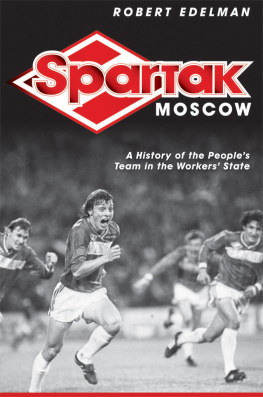Preface
Sitting here more than forty years after the fact, I have come to realize I have been studying Spartak since 1965. That summer, I went to the USSR for the first time to learn Russian at Moscow State University. The Vietnam War was just heating up, and like many undergraduates of that era, I was less than enamored of the United States and its imperialist ways. As many had done before me, I had come to Moscow to see how the future worked. Though I had studied Russian history for the previous three years and knew the USSR had its problems, I had hoped to find something positive about the place. After about a month, our group was taken to nearby Lenin Stadium to see that years cup final between Spartak and Dinamo Minsk. I cannot say my initial exposure to Spartak was a case of love at first sight. The entire experience turned out to be chaotic and frightening, with overzealous police beating drunk and disorderly fans. A halftime visit to the restroom is best left undescribed. By the time the night was over, I was well convinced the Bolshevik Revolution had been a big mistake. Soviet soccer fans were not a good advertisement for what many of us later came to call presently existing socialism.
I returned in 1970 as a graduate student to spend the academic year at Moscow State while researching my dissertation on prerevolutionary gentry politics. Living and working in the Soviet Union was far from an easy experience. Eventually I came to understand that I might hang on to a bit of sanity by engaging in the same kinds of activitiesin this case sportthat had helped me deal with stress in America. I made friends with male Soviet students who were glad to take me to football matches. After about ten such games, I began to wonder why one of the teams we went to see was always Spartak. I also wondered why the only sport they cared about was soccer. Couldnt we just once take in some gymnastics? They sat me down and explained. Football was the peoples game, and Spartak was the peoples team. No one cares about all that Olympic stuff. They also informed me that everyone hated the secret police, who funded Dinamo Moscow. Spartak had stood up to them. Whats more, they said, Spartaks leaders had been sent to the gulag by Stalin. The Spartak-Dinamo rivalry was the greatest in all of Soviet sport. On a global stage, it seemed to be as rich in political implication as the clash of the Spanish giants Real Madrid and Barcelona, the Glasgow Old Firm of Celtic and Rangers, and the Buenos Aires derbies of Boca Juniors and River Plate. For me, a sports-loving leftist critic of the Soviet regime, this seemed too good to be true. I could root for Spartak and live my politics. As I later found out, this was too good to be entirely true. Accordingly, my subtitle should be read ironically; not heroically.
Over the years, as I researched other aspects of Imperial Russian history, I never failed to go see Spartak play. I was always able to engage with Muscovites sitting in the stands, and I always got some version of my friends story. Similar conversations in scores of Soviet kitchens confirmed this view of Spartak as a site of judicious resistance. This did not mean that my fellow soccerati were about to break bread or share toasts with Sakharov and Solzhenytsin. These were not dissidents. Although they were not entirely satisfied with their world, they did not seek the overthrow of Communism. Rather, Spartak gave them a safe way to express a complicated and often contradictory set of attitudes.
While in Moscow, I began to do the things sports fans do the world over. Every day I tried to read the USSRs most popular newspaper, Sovetskii sport. In 1975, I bought a small television at a hard-currency shop and sneaked it into my dorm room at Moscow State. I watched every game I could, improving my Russian in the process. After a while, I could converse with any Moscow cab driver on the finer points of the game. I had an instant topic of mutual interest to discuss with most Soviet men. In an authoritarian system, winning the trust of strangers was difficult, but football created a bond that could lead to deeper friendships. It provided an entre into parts of Soviet society that were not readily available to most visiting scholars, whose contacts with Soviet citizens were largely limited to fellow intellectuals. With a few notable exceptions, the famed Russian intelligentsia was indifferent to such matters of popular culture as sport. Thoroughly enmeshed in the life of the mind, for the most part these were not people with much interest in matters of the body.
For decades, Western academics took their cues from their Soviet colleagues. Sport never made it onto the scholarly screen. In this respect I was no different from anyone else. It never occurred to me that I could do anything with all my research on Soviet sports; writing a book on such a topic was a shortcut to academic marginality. In 1986, however, Stanford University decided to put its imprimatur on sport by organizing an international conference. I was invited to give a paper simply because I was a student of Russia who had also worked as a stringer for the Associated Press covering the National Basketball Association. At the time, there was no one else in the United States working on the topic. This was during early perestroika, and I decided to write on what was then the contemporary spectator sports scene, using Sovetskii sport and newly available television transmissions that I obtained at Columbia University and the RAND Institute in Santa Monica. After giving the paper, I continued collecting material, largely because doing so was fun. I could pop in a tape, open a beer, lie back and work. A couple of years later, I gave a lecture at the University of Michigan, where several colleagues convinced me I had the makings of a book. After some contemplation, I decided to proceed, but not until coming to the conclusion that such a work should be a history rather than a commentary on current events.
I completed the research in 1990 after working in the library of Sovetskii sport. There was still a Soviet Union at the time, and it was not possible to use the relevant archives. Equally problematic was the fact that not everyone I met was willing to speak openly. Published in 1993, the book covered the full range of sporting experiences. Although I continued to keep up with the subject, I never intended to write another book on sports. By 1999, however, a great deal had changed. Sports history, especially the history of soccer, was now a booming field. The study of Soviet history had exploded with the opening of the archives after 1991. New questions were being asked, but in many cases the evidence needed to answer them proved hard to find. It became clear to many that we needed to look for new kinds of sources, new analytical realms and topics.
The peculiarities of the Soviet case made sport an especially rich source of fresh information and understanding. In the ten years previous to my starting this project, a number of authors, most of them British but not all of them academics, had produced studies of European soccer teams, including Glasgow Rangers, Barcelona, Real Madrid, West Ham United, Hansa Rostock, and many others. These works provided prisms through which it was possible to comprehend both the larger societies in which those clubs operated and the ways those societies influenced the clubs operations. Spartak, I thought, could do much the same for our understanding of Soviet history.










